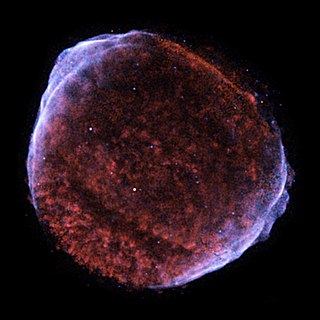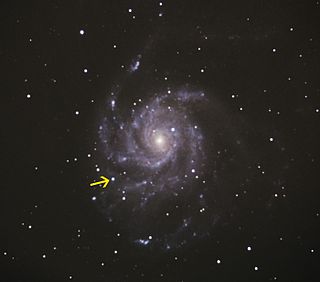
A supernova is a powerful and luminous explosion of a star. A supernova occurs during the last evolutionary stages of a massive star, or when a white dwarf is triggered into runaway nuclear fusion. The original object, called the progenitor, either collapses to a neutron star or black hole, or is completely destroyed to form a diffuse nebula. The peak optical luminosity of a supernova can be comparable to that of an entire galaxy before fading over several weeks or months.

SN 1604, also known as Kepler's Supernova, Kepler's Nova or Kepler's Star, was a Type Ia supernova that occurred in the Milky Way, in the constellation Ophiuchus. Appearing in 1604, it is the most recent supernova in the Milky Way galaxy to have been unquestionably observed by the naked eye, occurring no farther than 6 kiloparsecs from Earth. Before the adoption of the current naming system for supernovae, it was named for Johannes Kepler, the German astronomer who described it in De Stella Nova.
Timeline of neutron stars, pulsars, supernovae, and white dwarfs

3C 58 or 3C58 is a pulsar and supernova remnant within the Milky Way. The object is listed as No. 58 in the Third Cambridge Catalogue of Radio Sources.

First observed between August 4 and August 6, 1181, Chinese and Japanese astronomers recorded the supernova now known as SN 1181 in eight separate texts. One of only five supernovae in the Milky Way confidently identified in pre-telescopic records, it appeared in the constellation Cassiopeia and was visible and motionless against the fixed stars for 185 days. F. R. Stephenson first recognized that the 1181 AD "guest star" must be a supernova, because such a bright transient that lasts for 185 days and does not move in the sky can only be a galactic supernova.

SN 1006 was a supernova that is likely the brightest observed stellar event in recorded history, reaching an estimated −7.5 visual magnitude, and exceeding roughly sixteen times the brightness of Venus. Appearing between April 30 and May 1, 1006, in the constellation of Lupus, this "guest star" was described by observers across China, Japan, modern-day Iraq, Egypt, and Europe, and was possibly recorded in North American petroglyphs. Some reports state it was clearly visible in the daytime. Modern astronomers now consider its distance from Earth to be about 7,200 light-years or 2,200 parsecs.

A Type Ia supernova is a type of supernova that occurs in binary systems in which one of the stars is a white dwarf. The other star can be anything from a giant star to an even smaller white dwarf.

SN 1994D was a Type Ia supernova event in the outskirts of galaxy NGC 4526. It was offset by 9.0″ west and 7.8″ south of the galaxy center and positioned near a prominent dust lane. It was caused by the explosion of a white dwarf star composed of carbon and oxygen. This event was discovered on March 7, 1994 by R. R. Treffers and associates using the automated 30-inch telescope at Leuschner Observatory. It reached peak visual brightness two weeks later on March 22. Modelling of the light curve indicates the explosion would have been visible around March 3-4. A possible detection of helium in the spectrum was made by W. P. S. Meikle and associates in 1996. A mass of 0.014 to 0.03 M☉ in helium would be needed to produce this feature.

NGC 1309 is a spiral galaxy located approximately 120 million light-years away, appearing in the constellation Eridanus. It is about 75,000 light-years across, and is about 3/4s the width of the Milky Way. Its shape is classified as SA(s)bc, meaning that it has moderately wound spiral arms and no ring. Bright blue areas of star formation can be seen in the spiral arms, while the yellowish central nucleus contains older-population stars. NGC 1309 is one of over 200 members of the Eridanus Group of galaxies.

The known history of supernova observation goes back to 1006 AD. All earlier proposals for supernova observations are speculations with many alternatives.

Type Ib and Type Ic supernovae are categories of supernovae that are caused by the stellar core collapse of massive stars. These stars have shed or been stripped of their outer envelope of hydrogen, and, when compared to the spectrum of Type Ia supernovae, they lack the absorption line of silicon. Compared to Type Ib, Type Ic supernovae are hypothesized to have lost more of their initial envelope, including most of their helium. The two types are usually referred to as stripped core-collapse supernovae.
SN 2005E was a calcium-rich supernova first observed in January 2005 that scientists concluded was a new type of cosmic explosion. The explosion originated in the galaxy NGC 1032, approximately 100 million light years away.
SN 2002bj was the explosion of a star in the galaxy NGC 1821, located in the constellation Lepus. The explosion was discovered by Jack Newton in scans of images produced by Tim Puckett. Initially it had an apparent magnitude of about 14.7 and was categorized as a Type IIn supernova. However, in 2008 Dovi Poznanski discovered that the spectrum more closely resembled a Type Ia supernova. Further, the energy output was much lower than a typical supernova and the luminosity dropped at a dramatic pace.

SN 2011fe, initially designated PTF 11kly, was a Type Ia supernova discovered by the Palomar Transient Factory (PTF) survey on 24 August 2011 during an automated review of images of the Messier 101 from the nights of 22 and 23 August 2011. It was located in Messier 101, the Pinwheel Galaxy, 21 million light years from Earth. It was observed by the PTF survey very near the beginning of its supernova event, when it was approximately 1 million times too dim to be visible to the naked eye. It is the youngest type Ia ever discovered. About 13 September 2011, it reached its maximum brightness of apparent magnitude +9.9 which equals an absolute magnitude of about -19, equal to 2.5 billion Suns. At +10 apparent magnitude around 5 September, SN 2011fe was visible in small telescopes. As of 30 September the supernova was at +11 apparent magnitude in the early evening sky after sunset above the northwest horizon. It had dropped to +13.7 as of 26 November 2011.

SN 1895B was a supernova event in the irregular dwarf galaxy NGC 5253, positioned 16″ east and 23″ north of the galactic center. It is among the closest known extragalactic supernova events. The supernova was discovered by Williamina Fleming on December 12, 1895 after noticing an unusual spectrum on a photographic plate taken July 18, 1895, and was initially given the variable star designation Z Centauri. The light curve is consistent with an event that began ~15 days before the discovery plate was taken, and this indicates the supernova reached a peak visual magnitude of up to 8.49±0.03.

SN 2014J was a type-Ia supernova in Messier 82 discovered in mid-January 2014. It was the closest type-Ia supernova discovered for 42 years, and no subsequent supernova has been closer as of 2023. The supernova was discovered by chance during an undergraduate teaching session at the University of London Observatory. It peaked on 31 January 2014, reaching an apparent magnitude of 10.5. SN 2014J was the subject of an intense observing campaign by professional astronomers and was bright enough to be seen by amateur astronomers.
In astronomy, a calcium-rich supernova is a subclass of supernovae that, in contrast to more well-known traditional supernova classes, are fainter and produce unusually large amounts of calcium. Since their luminosity is located in a gap between that of novae and other supernovae, they are also referred to as "gap" transients. Only around 15 events have been classified as a calcium-rich supernova – a combination of their intrinsic rarity and low luminosity make new discoveries and their subsequent study difficult. This makes calcium-rich supernovae one of the most mysterious supernova subclasses currently known.

A hypernova is a very energetic supernova which is believed to result from an extreme core-collapse scenario. In this case, a massive star collapses to form a rotating black hole emitting twin astrophysical jets and surrounded by an accretion disk. It is a type of stellar explosion that ejects material with an unusually high kinetic energy, an order of magnitude higher than most supernovae, with a luminosity at least 10 times greater. Hypernovae release so much of gamma rays they usually appear similar to a type Ic supernova, but with unusually broad spectral lines indicating an extremely high expansion velocity. Hypernovae are one of the mechanisms for producing long gamma ray bursts (GRBs), which range from 2 seconds to over a minute in duration. They have also been referred to as superluminous supernovae, though that classification also includes other types of extremely luminous stellar explosions that have different origins.

IRAS 00500+6713 is the catalogued infrared source for an unusual nebula in Cassiopeia, while the central star has a designation WD J005311, with the whole system designated as Pa 30. The central star and its surrounding shell were created by the supernova seen in the year 1181 as reported by Chinese and Japanese observers. Both the nebula and central star have unique and extreme properties, pointing to their creation by a rare Type Iax supernova, where two ultra-dense white dwarfs in-spiral to a collision and explosion. The Pa 30 system was discovered in 2013 by amateur astronomer Dana Patchick, the extreme properties of the central star were first seen in 2019 by Gvaramadze and colleagues, and they recognized that the system was created in a low-luminosity supernova event from a merger of two white dwarfs.
Ken'ichi Nomoto is a Japanese astrophysicist and astronomer, known for his research on stellar evolution, supernovae, and the origin of heavy elements.

















